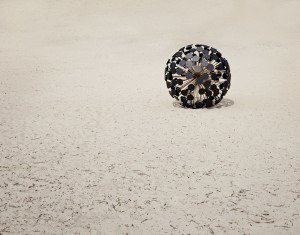Applied Design
dal 1/3/2013 al 30/1/2014
Segnalato da
Massoud Hassani
Markus Kayser
Martin Wattenberg
Fernanda Viegas
Ido Bruno
Arthur Brutter
Paola Antonelli
Kate Carmody
1/3/2013
Applied Design
The Museum of Modern Art - MoMA, New York
100 objects from the Museum's collection. Representing the new directions of contemporary design, the exhibition features outstanding examples of interface and interaction design, dynamic visualizations, products, furniture, 3D printed chairs and bowls, emergency equipment, and biodesign.

Curated by Paola Antonelli and Kate Carmody
The Museum of Modern Art presents Applied Design, an
installation in The Philip Johnson Architecture and Design Galleries showcasing approximately 100
objects from the Museum’s collection. Representing the new directions of contemporary design,
the exhibition features outstanding examples of interface and interaction design, dynamic
visualizations, products, furniture, 3D printed chairs and bowls, emergency equipment, and
biodesign.
A testament to this vitality and diversity, the objects on display range from a mine
detonator by the young Dutch/Afghani designer Massoud Hassani to a bowl made by transforming
desert sand into glass using only the energy of the sun. Also on display are the first 14 video
games to enter MoMA’s collection as part of ongoing research on interaction design. The exhibition
is organized by Paola Antonelli, Senior Curator, and Kate Carmody, Curatorial Assistant,
Department of Architecture and Design, The Museum of Modern Art, and is on view from March 2,
2013 until January 31, 2014.
In the past twenty years, design has branched out in new directions that have galvanized
young practitioners, sparked business models, and attracted worldwide public attention. Mine
Kafon for example, Massoud Hassani’s dandelion-shaped mine detonator, is equipped with a GPS
to record a safe path and designed to roll through mine fields.
If the object, made from bamboo
and biodegradable plastics, encounters a mine and detonates it, it will only partially destruct and
can be salvaged and reassembled into a new specimen ready for deployment. Hassani grew up in
the war-torn countryside of Afghanistan, where many of his friends were injured or killed by
landmines. Hassani drew on this personal experience to design a universal and low-cost tool that
can save many lives.
Markus Kayser’s Solar-sintered bowl was made using desert sand and sun. The process of
converting a powder into a solid by heating is known as sintering, and it is central in 3D printing, a
process by which computer-controlled machines deposit or solidify liquid or powdered resin layer
by layer, to create a three-dimensional rendering of a digital design. Kayser applied this
technology, which is closely identified with computers, robotics, and resins, to natural resources.
He tested his first manually operated solar 3D printing machine in 2011 in the Moroccan desert,
using silica sand, which turns to glass after heating and cooling. He completed a bigger, fully
automated, computer-driven version called SolarSinter later that year and tested it in the Sahara.
The bowl in the exhibition was produced by the SolarSinter and will have an accompanying video
that documents the process.
Wind Map, by Martin Wattenberg and Fernanda Viégas, is an online application that pulls
information from the publicly available National Digital Forecast database, rendering a living
portrait of the wind landscape over the United States. The Earthquake Proof Table by Ido Bruno
and Arthur Brutter—Brutter’s final project while a student in the Industrial Design program at the
Bezalel Academy of Art and Design in Jerusalem—is inexpensive, lightweight, and can provide
shelter and protection during earthquakes by absorbing the impact of falling debris.
The 14 video games, the seedbed for an initial wish list of about 40 to be acquired in the
near future, features: Pac-Man (1980), Tetris (1984), Another World (1991), Myst (1993), SimCity
2000 (1994), Vib-ribbon (1999), The Sims (2000), Katamari Damacy (2004), EVE Online (2003),
Dwarf Fortress (2006), Portal (2007), flOw (2006), Passage (2008), Canabalt (2009). The criteria
used to select these specific games emphasized not only the visual quality and aesthetic
experience of each game, but also the many other aspects—from the elegance of the code to the
design of the player’s behavior—that pertain to interaction design.
Interactive games such as Passage, Tetris, Pac-Man, Katamari Damacy, Vib-ribbon,
Cannabalt, flOw, Portal, and Another World are playable using controllers, while games such as
Eve Online, Dwarf Fortress, SimCity2000, The Sims, and Myst, are presented as walkthroughs or
demos. Headphones will be provided for games that have sound; an ongoing game soundtrack
that features the sounds of one game at a time will be audible in the galleries.
Press Contact:
Meg Montgoris, (212) 708-9757, meg_montgoris@moma.org
For downloadable high-resolution images, register at MoMA.org/press.
Opening: 2 March 2013
The Museum of Modern Art - MoMA
11 West 53 Street, New York
Hours: Wednesday through Monday, 10:30 a.m.–5:30 p.m. Friday, 10:30 a.m.–8:00 p.m. Closed Tuesday.
Museum Admission: $25 adults; $18 seniors, 65 years and over with I.D.; $14 full-time students with
current I.D. Free, members and children 16 and under. (Includes admittance to Museum galleries and film
programs). MoMA.org: No service charge for tickets ordered on MoMA.org. Tickets purchased online may be
printed out and presented at the Museum without waiting in line. (Includes admittance to Museum galleries
and film programs).



